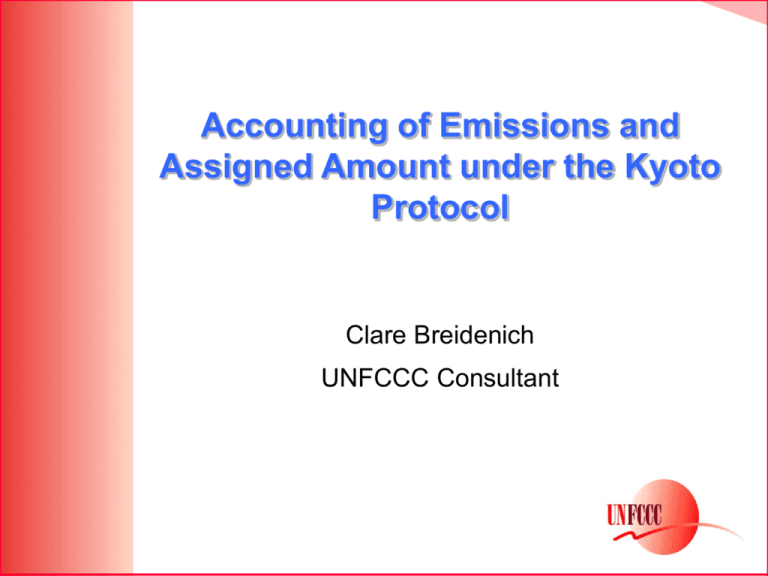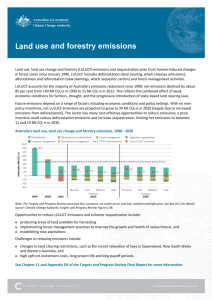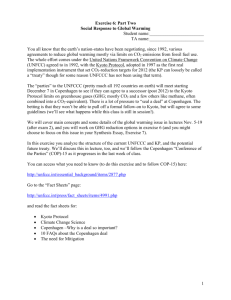Kyoto Protocol Reference Manual on Accounting for Emissions and
advertisement

Accounting of Emissions and Assigned Amount under the Kyoto Protocol Clare Breidenich UNFCCC Consultant Overview Introduction to Kyoto Compliance Architecture Role of reporting, review and compliance procedures in accounting of emissions and assigned amount Eligibility to participate in the Kyoto Mechanisms Accounting prior to, during and at end of commitment period LULUCF Accounting Compliance with Article 3.1 commitments Projected emissions Mechanisms acquisitions LULUCF activities < = > Total Annex A emissions Emissions side Annex B assigned amount Assigned amount side Kyoto Compliance Architecture Joint Implementation National Registries Reporting of quantitative information International Transaction Log CDM Compilation and Accounting Database (emissions, assigned amount information, mechanisms eligibility) GHG National Systems Reporting of qualitative information Review process Compliance Committee COP/MOP Role of reporting, review and compliance procedures in accounting for emissions and assigned amount Reporting, review and compliance procedures Enable establishment, suspension and reinstatement of mechanisms eligibility Verify that Party is accounting for emissions and assigned amount correctly Result in official data for compliance purposes Enable determination of Parties’ compliance with Article 3.1 commitment at end of commitment period Kyoto Protocol accounting Annex I Party systems National systems National registries Eligibility requirements Reporting process Kyoto Protocol units Emissions inventories Review and compliance processes Secretariat compilation and accounting database Emissions 2008 - 2012 > = < Assigned amount 2008 - 2012 Article 3.1 compliance assessment Review Tasks related to accounting Review inventories, and where appropriate, recommend application of adjustments Review transactions of Kyoto Protocol units and, where appropriate, recommend corrections Review implementation of requirements related to mechanisms eligibility Raise questions of implementation for consideration by the Compliance Committee All QUIs related to accounting considered by Enforcement Branch Inventory Adjustments Intended to correct problems for purpose of accounting for emissions and assigned amount Recommended by ERT when inventory incomplete or inconsistent with IPCC good practice guidance Party provided opportunity to correct problem Applied with consent of Party or by Compliance Committee Always result in conservative estimate BY emissions reduced CP emissions increase Adjustments to CP inventories may have consequences for mechanisms eligibility Eligibility to Participate in the Kyoto Mechanisms Kyoto Mechanisms eligibility requirements Participation in Kyoto mechanisms dependent on compliance with specific methodological and reporting requirements: Party to the Kyoto Protocol Initial assigned amount established National System in place National Registry in place Annual Inventory Annual information on assigned amount, and accounted correctly Eligibility Requirements by mechanism Same six criteria apply, but consequences differ by mechanism: Emissions trading: Must be in compliance with all requirements to transfer or acquire units Joint Implementation: Track one: Must meet all requirements Track two: Must have national registry in order to issue and transfer ERUs CDM: Must meet all requirements in order to use CERs, tCERs and lCERs Inventory eligibility requirement Decision 15/CMP.1 specifies that a Party will fail to meet the annual inventory requirement if and only if: Inventory not submitted w/in 6 weeks of due date Omission of Annex A key source that accounts for 7% or more of annual emissions Total adjustments to Annex A sources in a year of the commitment period exceeds 7% of submitted emissions At any point in time, sum of adjustments across years of the commitment period exceeds 20% compared to submitted An adjustments is applied in three consecutive years to key source that accounts for 2% or more of Annex A emissions Reporting requirements for eligibility National Inventory Initial report, Annual reports beginning in 2007 All years from BY to most recent within 6 weeks of due date All sectors (Annex A and Convention LULUCF Tables) No omissions of Annex A sources of 7% or more Beginning in 2010 Submission of KP LULUCF Magnitude of adjustments for Annex A emissions apply Annual AA information starting year after first transfer or acquisition of Kyoto Protocol units If transfer in 2008, report in 2009 Process for establishing eligibility Normal outcome of reporting, review & compliance procedures Automatically eligible 16 months after submission of initial report, unless Enforcement Branch determines at an earlier date that Party fails to meet one or more of the requirements Party remains eligible until and unless Enforcement Branch suspends eligibility If suspended, Party can request reinstatement Directly to Compliance Committee Through the Review Process (expedited review procedures) Accounting before, during and after commitment period Initial Accounting Submission and review of initial report leads to Establishment of initial assigned amount in tonnes of CO2 eq Determination of Party’s eligibility to participate in each of the Kyoto mechanisms Recording of parameters for LULUCF accounting Possible adjustments to BY emissions, and consequent reduction in initial assigned amount Following review & resolution of any QUIs by compliance committee, data recorded in CAD and provided to ITL Registry can now issue AAUs If eligible, can begin transferring and acquiring Kyoto Protocol units Annual Accounting 2007 – 2009 Submission of annual report voluntary under Kyoto, but… required for full eligibility to participate in the Kyoto Mechanisms Convention inventory AA information, when applicable Inventories not subject to adjustment during this period Party’s holdings of Kyoto Protocol units recorded annually in CAD, after review & resolution of QUIs Compliance with mechanisms eligibility requirements updated as necessary and provided to ITL Eligible Parties continue to transfer and acquire units Reporting of assigned amount info Decision 15/CMP.1 requires information on its aggregate holdings and transactions of Kyoto Protocol units in its annual report. begin submitting this information the year after it first transfers or acquires units (probably in 2009) Decision 14/CMP.1 adopted Standard Electronic Format (SEF) for reporting Kyoto Protocol units Information from national registry Summary of holdings and transactions of Kyoto Protocol units for previous calendar year SEF Tables Aggregate holdings of Kyoto Protocol units at the beginning and end of the previous calendar year by unit type and account type. Summary of transactions Internal transactions (issuance, cancellation, retirement, etc.) Transfer to and acquisitions from other registries Expiration and replacement of tCERs and lCERs Cumulative additions to and subtractions from assigned amount to date Example SEF Table Party Submission year Reported year Commitment Period Table 2 (a). Annual internal transactions Additions Subtractions Unit type Transaction type AAUs ERUs RMUs CERs Unit type tCERs lCERs tCERs lCERs Article 6 issuance and conversion Party-verified projects Independently verifed projects Article 3.3 and 3.4 issuance or cancellation 3.3 Afforestation and reforestation 3.3 Deforestation 3.4 Forest management 3.4 Cropland management 3.4 Grazing land management 3.4 Revegetation Article 12 afforestation and reforestation Replacement of expired tCERs Replacement of expired lCERs Replacement for reversal of storage Replacement for non-submission of certification report Other cancellation Sub-total Retirement Unit type Transaction type Retirement AAUs ERUs RMUs CERs AAUs ERUs RMUs CERs tCERs lCERs Annual Accounting 2010 – 2013 Annual reports mandatory: Convention inventory + KP LULUCF Accounting for annually elected LULUCF activities SEF information Changes in national systems and registries (3.14 info required, but not relevant for accounting) Adjustments May be applied for Annex A emissions May be applied for annually accounted LULUCF activities Annual Accounting 2010 – 2013 Information recorded annually in CAD: Annex A emissions & any adjustments applied For annually accounted LULUCF activities, Net emissions/removals and any adjustments applied Accounting quantity Holdings and transactions of Kyoto Protocol units Compliance with mechanisms eligibility requirements updated as necessary Registry must issue or cancel units for annually accounted LULUCF activities each year Eligible Parties continue to transfer and acquire units Annual Accounting 2014 Annual Report Final inventory data for commitment period (Last chance to recalculate emissions & removals) Accounting for CP-accounted LULUCF activities Information recorded in CAD Total Annex A emissions for commitment period Indicates total quantity of units to be retired Final accounting quantity for all 3.3 and 3.4 activities (annual and CP accounting) Annual Accounting 2014 After review and compliance procedures complete for all Parties, ‘true-up period’ begins Exact date to be determined by COP/MOP decision Registry must undertake final transactions of Kyoto Protocol units Transfers & acquisitions of KP Units All issuance/cancellation for CP-elected LULUCF activities Retirement of sufficient units to cover total Annex A emissions 2015 Accounting True-up period report AA information for 2014 calendar year + true-up period in 2015 All units retired for commitment period All units that Party wishes to ‘carry-over’ to next commitment period Review tasks Total Annex A emissions ≤ retired units? Check units available for carry-over Compliance determination: Deduction of units at 1.3:1 for excess emissions Suspension of transfer rights for non-compliance Following review and compliance procedures Registry can initiate carry-over of valid units Any Party found in non-compliance must cancel units from 2nd commitment period accounts Summary of Information required in Annual Reports Reporting Element 2007 2008 2009 2010 2011 2012 2013 2014 Convention Inventory ● ● ● ● ● ● ● ● ● ● ● ● ● ● ● ● ● ● ● ● ● ● ● KP LULUCF Inventory SEF & AA information Calculation of AQ for Annual LULUCF activities ○ ● ● ● Calculation of AQ for CP LULUCF activities 3.14 Information (not relevant for accounting) 2015 (True-up report) ● ● ● ● ● Units Retired ● Units for carry-over ● Accounting for LULUCF Activities under Articles 3.3 and 3.4 General approach to LULUCF Accounting Accounting frequency for each 3.3 activity and each elected 3.4 activity indicated in Party’s initial report For annually elected activities, Party must issue or cancel units corresponding to net removals or net emissions from that activity following review and compliance procedures in each of years 2010 – 2014 For commitment period elected activities, Party must issue or cancel units corresponding to net removals or net emissions over the entire commitment period following review and compliance procedures in 2014 only Parties report Emissions and removals (in KP CRF tables) reported annually, regardless of accounting frequency for the activity Calculation of the ‘accounting quantity’ only when activity is accounted The Accounting Quantity for LULUCF activities Represents the cumulative obligation to issue or cancel units to date for a given CP year A negative AQ indicates cumulative net removals issuance of RMUs A positive AQ indicates cumulative net emissions cancellation of units For CP-elected activities, AQ will be calculated and reported only once in 2014 For annually-elected activities, AQ will be calculated and reported annually and will capture all emissions and removals to date (E.g. 2011 AQ will be based on net emissions and removals in 2008 and 2009) Will capture any recalculations of estimates for previous CP years Issuance and Cancellation AQ to be calculated by Party, in accordance with sinks accounting rules and checked by ERT Any adjustments applied to emissions and removals for an activity will be result in modification of accounting quantity AQ will be recorded in CAD and provided to ITL Party’s national registry can then issue or cancel units Quantity of units to be issued or cancelled at any point in time depends on AQ, and quantity of units previously issued or cancelled Relationship of AQ to issuance & cancellation Submission Year 2010 2011 2012 2013 2014 Inventory Year 2008 2008 2009 2008 2009 2010 2008 2009 2010 2011 2008 2009 2010 2011 2012 Net Emissions & Removals -15 -15 -15 -15 -15 -15 -15 -15 -15 -15 -10 -10 -10 -10 -10 Accounting Quantity Action -15 Issue 15 RMUS -30 Issue 15 RMUs -45 Issue 15 RMUs -60 Issue 15 RMUs -50 Cancel 10 units Example Calculation of LULUCF AQs Net emissions/removals (1) GREENHOUSE GAS SOURCE AND SINK ACTIVITIES 2008 BY 2009 2010 2011 2012 Accounting Quantity (2) Accounting limits Total (Mt CO2 equivalent) A. Article 3.3 activities A.1. Afforestation & Reforestation A.1.1. Units of land not harvested since the beginning of the commitment period A.1.2. Units of land harvested since the beginning of the commitment period Unit A Unit B Unit C Unit D Unit E A.2. Deforestation B. Article 3.4 activities B.1. Forest Management (if elected) FM cap 3.3 offaset B.2. Cropland Management (if elected) B.3. Grazing Land Management (if elected) B.4. Revegetation (if elected) -75 -2 -10 -10 -10 -10 -40 -40 -2 -4 -4 -3 -5 -30 -2 10 -3 10 -5 200 -5 -3 -2 0 -5 0 -3 -6 15 -4 -5 -10 -12 -3 6 3 -20 160 -35 -12 -3 0 0 -20 160 -60 -80 -60 -40 -240 -10 -10 -10 -150 65 -65 85 -85 -28 -16 -6 -36 -8 20 0 5 -2 -3 -3 -4 -12 0 -3 -3 -5 -5 -16 -32 Reference Manual on accounting of emissions & assigned amount Why Reference Manual? Rules for implementation of the Protocol are scattered across numerous decisions Many questions from Annex I Parties regarding requirements for implementation of the Protocol Need to facilitate a common, consistent approach by experts and institutions involved in supporting and assessing implementation – Parties, ERTs, Compliance Committee, Secretariat Available November, 2007? Reference Manual Contents Overview of Kyoto Protocol and Principal Commitments Particular focus on requirements and systems that relate to accounting of emissions and assigned amounts Process for accounting for emissions and assigned amount prior to, during and after commitment period Requirements for participation in the Kyoto Protocol mechanisms Eligibility criteria procedures for establishment, maintenance, suspension and reinstatement of eligibility Detailed chapters on requirements related to accounting of emissions and assigned amount








